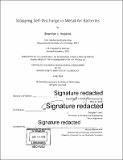| dc.contributor.advisor | Douglas P. Hart. | en_US |
| dc.contributor.author | Hopkins, Brandon J. (Brandon James) | en_US |
| dc.contributor.other | Massachusetts Institute of Technology. Department of Mechanical Engineering. | en_US |
| dc.date.accessioned | 2019-02-15T19:16:07Z | |
| dc.date.available | 2019-02-15T19:16:07Z | |
| dc.date.copyright | 2018 | en_US |
| dc.date.issued | 2018 | en_US |
| dc.identifier.uri | http://hdl.handle.net/1721.1/120466 | |
| dc.description | Thesis: Ph. D., Massachusetts Institute of Technology, Department of Mechanical Engineering, 2018. | en_US |
| dc.description | Cataloged from PDF version of thesis. | en_US |
| dc.description | Includes bibliographical references (pages 67-78). | en_US |
| dc.description.abstract | Metal-air batteries boast high theoretical energy densities, but negative electrode corrosion can severely reduce their usable capacity and commercial utility. Most methods to mitigate corrosion focus on electrode and electrolyte modification such as electrode alloying, electrolyte additives, and gel and nonaqueous electrolytes. These methods, however, either insufficiently suppress the parasitic reaction or compromise power and energy density. This thesis focuses on a different approach to corrosion mitigation involving electrolyte displacement from the electrode surface. Multiple electrolyte-displacement concepts were generated and investigated. The most promising of the concepts was the reversible displacement of the electrolyte from the electrode surface with an oil. To enable this method, the fundamental physics of underwater oil-fouling resistant surfaces was investigated, tested, and characterized. Design equations that aid in the appropriate selection of electrodes, displacing oils, and separator membranes were also developed. The oil displacement method was demonstrated in a primary (single-use) aluminum-air (Al-air) battery that achieved a 420% increase in useable energy density and was estimated to enable pack-level energy densities as high as 700 Wh 1- and 900 Wh kg-1. This method could, in principle, be used in any of the metal-air batteries, aqueous or nonaqueous, or in other energy storage systems that suffer from corrosion if appropriate displacing oils and separator membranes are found using the discussed design principles. With the oil displacement method, aqueous metal-air batteries that rely on abundant, broadly dispersed materials could provide safe, low-cost, sustainable primary and secondary (rechargeable) batteries for many applications including grid-storage, off-grid storage, robot power, and vehicular propulsion. | en_US |
| dc.description.statementofresponsibility | by Brandon J. Hopkins. | en_US |
| dc.format.extent | 78 pages | en_US |
| dc.language.iso | eng | en_US |
| dc.publisher | Massachusetts Institute of Technology | en_US |
| dc.rights | MIT theses are protected by copyright. They may be viewed, downloaded, or printed from this source but further reproduction or distribution in any format is prohibited without written permission. | en_US |
| dc.rights.uri | http://dspace.mit.edu/handle/1721.1/7582 | en_US |
| dc.subject | Mechanical Engineering. | en_US |
| dc.title | Stopping self-discharge in metal-air batteries | en_US |
| dc.type | Thesis | en_US |
| dc.description.degree | Ph. D. | en_US |
| dc.contributor.department | Massachusetts Institute of Technology. Department of Mechanical Engineering | |
| dc.identifier.oclc | 1083672099 | en_US |
